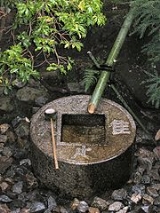
Tsukubai
Encyclopedia

Temple
A temple is a structure reserved for religious or spiritual activities, such as prayer and sacrifice, or analogous rites. A templum constituted a sacred precinct as defined by a priest, or augur. It has the same root as the word "template," a plan in preparation of the building that was marked out...
s for visitors to purify themselves by the ritual washing of hands and rinsing of the mouth (perform ablutions). This type of ritual cleansing
Ritual purification
Ritual purification is a feature of many religions. The aim of these rituals is to remove specifically defined uncleanliness prior to a particular type of activity, and especially prior to the worship of a deity...
is also the custom for guests attending a tea ceremony
Tea ceremony
A tea ceremony is a ritualised form of making tea. The term generally refers to either chayi Chinese tea ceremony, chado Japanese tea ceremony, tarye Korean tea ceremony. The Japanese tea ceremony is more well known, and was influenced by the Chinese tea ceremony during ancient and medieval times....
.
Tsukubai are usually of stone, and are often provided with a small scoop, laid across the top, ready for use. A supply of water is provided via a bamboo pipe called a kakei.
The tsukubai shown here, from the Ryōan-ji
Ryoan-ji
is a Zen temple located in northwest Kyoto, Japan. Belonging to the Myoshin-ji school of the Rinzai branch of Zen Buddhism, the temple and karesansui garden is one of the Historic Monuments of Ancient Kyoto, a UNESCO World Heritage Site....
temple, is famous for the inscribed poem. The kanji written on the surface of the stone are without significance when read alone. If each is read in combination with 口 (kuchi), which the central bowl is meant to represent, then the characters become 吾, 唯, 足, 知. This is read as "ware tada taru (wo) shiru" and translates literally as "I only know plenty" (吾 = ware = I, 唯 = tada = only, 足 = taru = plenty, 知 = shiru = know). The meaning, "what one has is all one needs", is meant to reinforce the basic anti-materialistic teachings of Buddhism
Buddhism
Buddhism is a religion and philosophy encompassing a variety of traditions, beliefs and practices, largely based on teachings attributed to Siddhartha Gautama, commonly known as the Buddha . The Buddha lived and taught in the northeastern Indian subcontinent some time between the 6th and 4th...
.
External links
- Tsukubai Design & Construction - Tea instructor Elliot Mitchnick discusses the design and construction of the Tsukubai arrangement.

